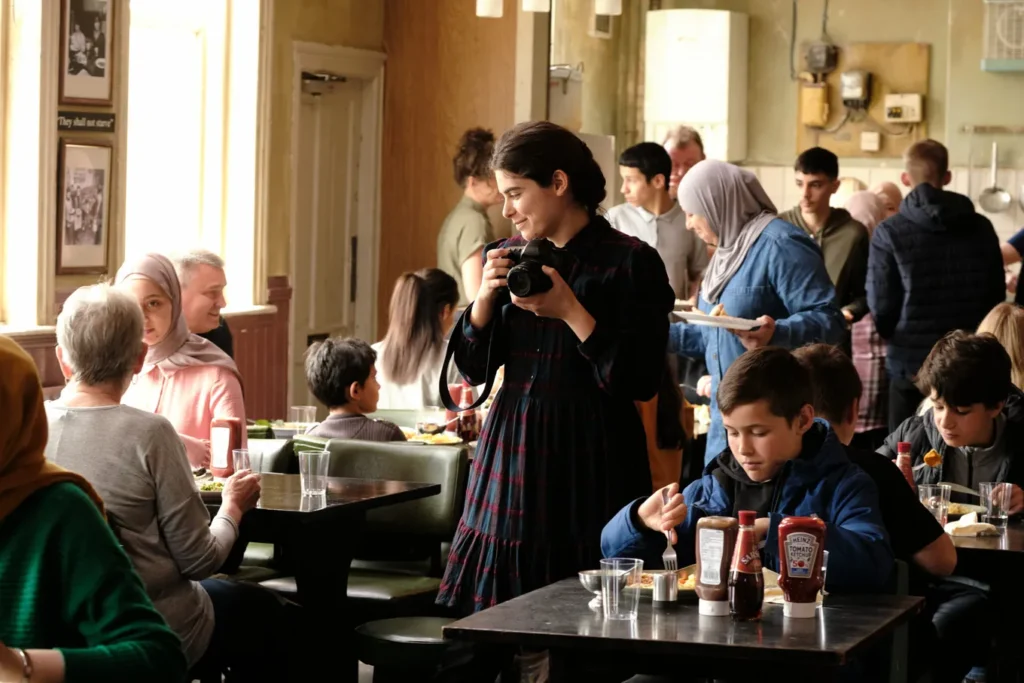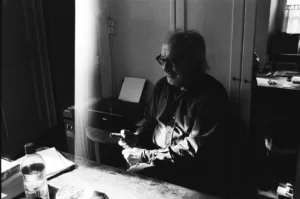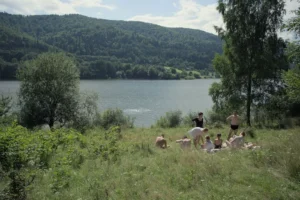Ken Loach Forever
The maestro’s final film is a parting plea for solidarity. Ken Loach on the set of “The Old Oak.” Joss Barratt, Sixteen Films.
Ken Loach on the set of “The Old Oak.” Joss Barratt, Sixteen Films.
Ken Loach says “The Old Oak” is his swan song. If true, his 17th feature to premiere at Cannes serves as a fitting capstone to a virtuosic career that began in 1969 with a story about a boy and a bird. For half a century, Loach, who turns 87 this month, has pursued a project marked by roughly equal measures of humanistic inquiry, political statement and precise artistry, wrapped in a signature kitchen-sink realism that has influenced a generation of social realist filmmakers like Lynne Ramsey and Andrea Arnold.
In keeping with the highlights of Loach’s filmography, “The Old Oak” is overt in its politics and social vision without being utopian or didactic. Co-written by Loach’s longtime writing partner, Paul Laverty, it’s a story of refugees whose depiction of human struggle and cultural cross-pollination in post-industrial Britain is characteristically gentle. It generates beauty from the simplicity of characters placing the most raw and flammable parts of themselves on full display, until the only remaining choice is to embrace one’s neighbors. Rather than show you what solidarity looks like, Loach lets you in on what it feels like. The result is one of his most moving films, a presentation of the world not as Loach thinks it should be, but as it might and can become, despite its and our imperfections.
In keeping with the highlights of Loach’s filmography, “The Old Oak” is overt in its politics and social vision without being utopian or didactic.
The film’s title refers to a rundown pub in a former mining village in northeast England. The watering hole is the last public refuge for the local townspeople amid severe economic downturn, and it becomes a quiet battleground when the village sees an influx of Syrian refugees, who don’t so much alter the county’s fabric as much as they inadvertently lay bare numerous governmental failings and cultural frustrations. While much of the film centers on the local townspeople, it opens with photographs snapped by young refugee Yara (Ebla Mari) on the day she arrives with her mother and younger siblings. The scene’s audio plays as it normally would, capturing dialogue in full. But its still images linger on specific, charged moments of kindness and cruelty in equal measure. Some townspeople, like middle-aged Old Oak owner “TJ” Ballantyne (Dave Turner), are dedicated to lending a helping hand. Others, like pub regulars like Charlie (Trevor Fox) and Vic (Chris McGlade), make their suspicions known.
Superficial ethnic enmity would have been an easy foundation for the townspeople’s aggression. But Loach paints a multifaceted portrait in which racism is but one of several cultural catalysts driving the local psychology. Even the film’s most objectionable characters are granted the richness Loach usually affords his heroic figures, as they complete the emotional tapestry of the town.. This is seen most clearly and immediately in the meek, bespectacled Charlie, whose sickly wife is his main concern and who feels abandoned by the institutions and structures he feels should have been protecting his friends and family, between ensuring jobs and basic infrastructural upkeep, rather than diverting funds towards assisting outsiders, or allowing local apartments to be bought up by real-estate vultures for an easy turnover. The sardonic, outspoken Vic, meanwhile, petitions TJ for the use of the abandoned back room of the Old Oak — once a meeting place for mining unions, lined with photographs taken during numerous strikes — in order to hold a public forum for the villagers’ longtime residents to draw a line in the proverbial sand between what’s theirs and what the arriving refugees have rights to. The result is interpersonal tensions between old friends and comrades.

The Syrian refugees have lost everything, but the white villagers have lost plenty, too. Without playing an easy game of both-sides-ism, “The Old Oak” offers a more discomforting portrait of the modern migrant crisis. Yara, a strong-willed girl who learned English from nurses in a migrant camp, keeps her head above water by trying to make her own in-roads with the locals, often with TJ’s help. This dynamic is the movie’s heart and soul, depicting the initial trepidations and eventual euphoria of both mutual understanding and mutual aid. As the film goes on, Yara and TJ exchange personal histories, and find common ground through tales of resistance and food; “When you eat together, you stick together,” a banner from an old union photo, becomes their motto in the present.
The town has a long history of union activity, of which its citizens remain proud. Its failings over the years, however, have left them exhausted towards the very thought of optimism and reluctant to expand their idea of unity, if it runs the risk of someone encroaching on what they see as theirs. The ensuing skirmishes are a fight for both history and public space, with tensions that boil over through violence and sabotage that feel ultimately fatalistic, since the locals’ frustrations are seldom aimed at those truly responsible for their economic predicaments. Those culpable are too far up the ladder — too far out of reach.
TJ and Yara’s have rich intellectual and emotional interiority, which Loach disguises beneath familiar naturalism. (The way we get to know TJ the most is through his loving interactions with his adorable puppy Marra, or in moments of mundane frustration, like when he tries to fix the pub’s crumbling signage). Loach’s sense of cinematic reality is often born from a documentarian camera that allows nonprofessional actors to play in lengthy, unbroken takes, which he captures from oblique angles, allowing the dynamics between characters (and their relationships to the spaces around them) to bear the storytelling burden in most scenes, especially those with plentiful dialogue. What’s often missed in Loach’s films, especially in “The Old Oak,” is the moments he eventually draws focus away from his more conversational rhythms, towards a more calculated and operatic storytelling form. He can transition between these with such smoothness, the switch often goes unnoticed.
Superficial ethnic enmity would have been an easy foundation for the townspeople’s aggression. But Loach paints a multifaceted portrait in which racism is but one of several cultural catalysts driving the local psychology.
In moments of his characters’ personal confessions and grief, he captures TJ and Yara in isolated, head-on close-ups that can seem like questionable shot choices at odds with his usual unobtrusive approach. However, Loach slips into this cinematic intimacy not before or after these conversations, but during them, allowing his actors’ lived-in performances to act as the aesthetic connective tissue between his naturalistic and formalist modes. Swapping camera lenses when one goes from a medium shot to a close-up is hardly revolutionary, but in the hands of Loach and his cinematographer, Robbie Ryan, the switch from a wide to a telephoto lens not only blurs the background, but isolates the characters from time and space. It’s as if their monologues — during which they reach into painful or resilient moments from their past — are meant to anchor them in an unstable present. The movie lives and breathes through the sorrows they leave unsaid, floating in the soft-focus ether.
There’s a pervasive sense of physical and emotional solitude the characters try to overcome, an idea Loach contrasts by using still photographs taken by Yara in the present, and by TJ’s father decades ago during the various mining strikes, capturing moments of joy and unity. These bustling photos are slivers of history unmoored, representing a form of exuberant solidarity that now feels beyond reach — if it truly existed at all, in any form more tangible than TJ’s paternal nostalgia. And yet, they represent a guiding credo that exists in the town’s collective subconscious and memory, the way Loach’s own cinematic images begin from a point of realism, and end up transformed into something aspirational. The people in photos like TJ’s are long dead, but in his final film, Loach affirms their immortality in a way, as if their stories of unity from decades past, when witnessed and recounted today, render them reborn.
The politics of Loach’s films are seldom subtle, but they’re more than political thesis statements. His long-standing cinematic project is to depict the harrowing circumstances foisted upon working people and the downtrodden by a callous ruling class, without whitewashing or sandblasting the dreams, desires and foibles of those being quashed. Ultimately, it is the recognizable resilience of these people that gives them a chance to push back and reclaim their narratives. His politics are nothing without the human lives in which they are embedded, because what are stories but fuel for fires yet to be set?
Your support matters…Independent journalism is under threat and overshadowed by heavily funded mainstream media.
You can help level the playing field. Become a member.
Your tax-deductible contribution keeps us digging beneath the headlines to give you thought-provoking, investigative reporting and analysis that unearths what's really happening- without compromise.
Give today to support our courageous, independent journalists.






You need to be a supporter to comment.
There are currently no responses to this article.
Be the first to respond.